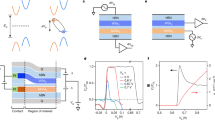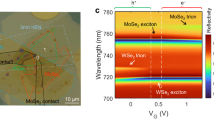Abstract
We propose a simple physical model describing the transition of an exciton gas to a conducting exciton liquid. The transition occurs due to cohesive coupling of excitons in the vicinity of the critical point, which is associated with transformation of the exciton ground state to the conduction band and the emergence of conduction electrons. We calculate the cohesion binding energy for the exciton gas and, using it, derive the equations of state, critical parameters, and binodal. The computational method is analogous to that used by us earlier [5] for predicting the vapor-liquid (insulator-metal) phase transition in atomic (hypothetical, free of molecules) hydrogen and alkali metal vapors. The similarity of the methods used for hydrogen and excitons makes it possible to clarify the physical nature of the transition in the exciton gas and to predict more confidently the existence of a new phase transition in atomic hydrogen.
Similar content being viewed by others
References
L. V. Keldysh, Sov. Phys.—Usp. 13(2), 292 (1970).
G. A. Thomas, T. M. Rice, and J. C. Hensel, Phys. Rev. Lett. 33, 219 (1974).
V. Filinov, M. Bonitz, P. R. Levashov, V. E. Fortov, W. Ebeling, and M. Schlanges, Contrib. Plasma Phys. 43, 29 (2003).
G. E. Norman and A. N. Starostin, Teplofiz. Vys. Temp. 6, 410 (1968).
A. L. Khomkin and A. S. Shumikhin, Plasma Phys. Rep. 39(10), 857 (2013).
A. L. Khomkin and A. S. Shumikhin, J. Exp. Theor. Phys. 118(1), 72 (2014).
J. Bardeen, J. Chem. Phys. 6, 367 (1938).
A. L. Khomkin and A. S. Shumikhin, J. Exp. Theor. Phys. 114(1), 89 (2012).
S. M. Stishov, Phys. Rev. B: Condens. Matter 47, 12260 (1993).
A. A. Likal’ter, Phys.—Usp. 43(8), 755 (2000).
H. Juranek and R. Redmer, J. Chem. Phys. 112, 3780 (2000).
L. D. Landau and Ya. B. Zel’dovich, Zh. Eksp. Teor. Fiz. 14, 32 (1944).
A. L. Khomkin and A. S. Shumikhin, Vestn. Kazan. Tekhnol. Univ. 17, 67 (2014).
Author information
Authors and Affiliations
Corresponding author
Additional information
Original Russian Text © A.L. Khomkin, A.S. Shumikhin, 2015, published in Zhurnal Eksperimental’noi i Teoreticheskoi Fiziki, 2015, Vol. 147, No. 4, pp. 775–781.
Rights and permissions
About this article
Cite this article
Khomkin, A.L., Shumikhin, A.S. Physical model of the vapor-liquid (insulator-metal) transition in an exciton gas. J. Exp. Theor. Phys. 120, 672–677 (2015). https://doi.org/10.1134/S106377611504007X
Received:
Published:
Issue Date:
DOI: https://doi.org/10.1134/S106377611504007X




